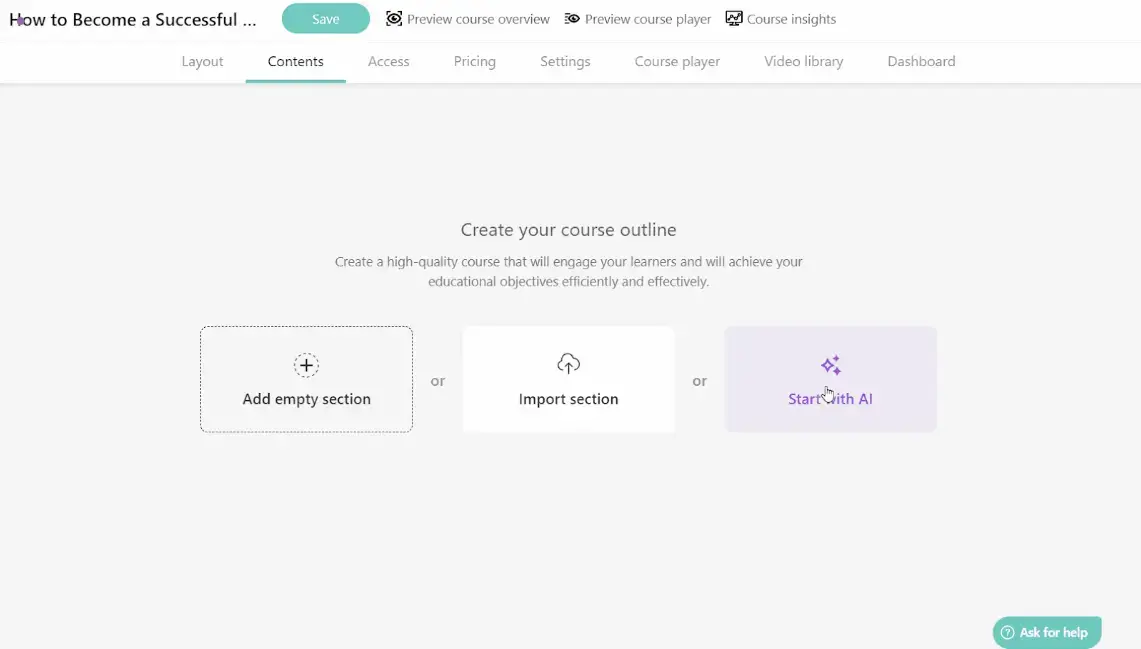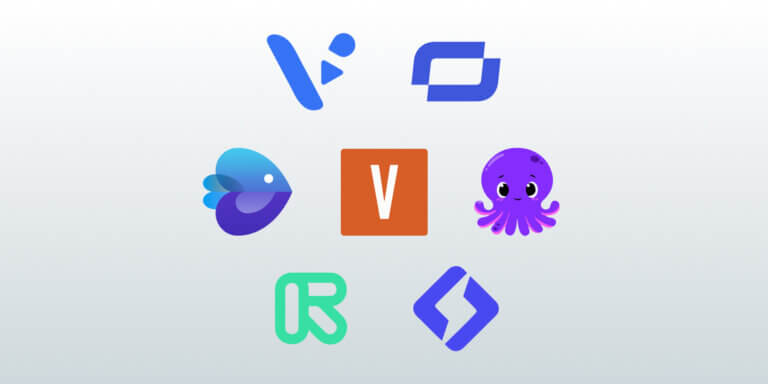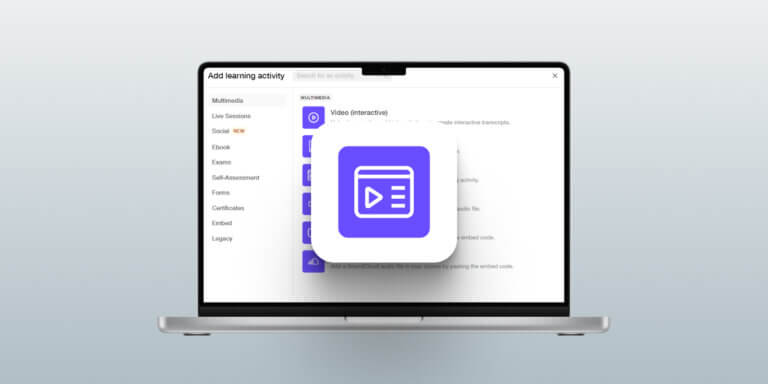Table of Contents
I’ve been there—writing learning objectives that feel vague, hard to measure, or simply uninspiring. As learning designers, we want clear, actionable goals, but let’s face it, writing those objectives is often the hardest part. The difference between a well-crafted objective and a poorly written one can determine whether your course succeeds or falls flat.
AI tools can quickly turn vague goals into precise, measurable outcomes. For instance, AI can take that previous, vague objective and transform it into something like: “Identify and apply three key project management frameworks to solve real-world business challenges.”
This objective is specific, actionable, and measurable—exactly what you need to set learners up for success. AI-powered tools analyze your course content, suggest specific action verbs, and align your objectives with proven instructional frameworks like Bloom’s Taxonomy.
In short, AI helps you move from generic to targeted learning outcomes, saving you time and improving the quality of your courses.
What Are Learning Objectives?
Learning objectives are the cornerstone of effective teaching and learning. They are specific, measurable, and achievable goals that define what students should learn and be able to do by the end of a lesson, unit, or course. By providing a clear direction for instruction and assessment, learning objectives ensure that students meet the desired learning outcomes.
When you create lesson plans, these objectives act as your guiding star, helping you design activities and assessments that align with educational standards and best practices. Whether you’re teaching students how to solve quadratic equations or guiding them through a complex project, well-crafted learning objectives keep your course focused and your students on track.
How to Write Learning Objectives With AI
Let’s start building learning objectives in practice using this article as a step-by-step guide backed up with some effective prompt examples.
Step 1: Choose the Framework – ABCD vs. SMART Objectives
When writing learning objectives, it’s essential to use a clear framework to guide you. Two of the most effective frameworks are ABCD and SMART. Choosing the right one sets the foundation for crafting clear, actionable, and measurable objectives.
ABCD Framework:
The ABCD Objectives Framework is a tried-and-true model for crafting precise learning objectives. It breaks down the objective into four essential components:
By using the ABCD framework, educators can create clear and concise learning objectives that are aligned with educational standards and best practices. This structured approach ensures that objectives are not only specific and measurable but also relevant to the target audience and grade level.
SMART Framework:
The SMART Objectives Framework is another powerful tool for creating effective learning objectives. It emphasizes five key components:
Using the SMART framework, educators can create learning objectives that are clear, concise, and achievable. This framework ensures that objectives are not only aligned with educational standards but also tailored to the needs of the students.
Choose a structured framework that helps you create measurable learning objectives. Whether you’re designing for a large corporate training or a small online course, the choice between ABCD and SMART depends on how you want to assess learner success. ABCD works best when you need highly structured, detailed objectives, while SMART is ideal for broader learning outcomes.
AI can analyze your course and recommend which framework will better suit your objectives based on your content and assessment methods. You no longer need to guess which framework works best; AI can provide suggestions tailored to your course structure and outcomes.
Prompt example 1:
Act as an instructional designer. Evaluate my course structure and assessment methods. Recommend whether the ABCD or SMART framework is better suited for crafting my learning objectives. The course is “101 Travel Photography,” focusing on beginner-level individuals in photography. Below you will find my course structure and assessment methods: [add the course structure and assessment methods].
Prompt example 2:
Act as an instructional designer with expertise in crafting learning objectives. Consider the course description and desired learning outcomes for the course “Data Analysis in Social Sciences with R,” aimed at undergraduate social sciences students with no prior knowledge of R but with a basic understanding of data analysis. Suggest which framework—ABCD or SMART—would be more effective for designing the learning outcomes for the course. [add the course description and the desired learning outcomes].
By choosing the right framework, you’ve laid the groundwork for success. But a framework alone isn’t enough. To truly elevate your course, the next step is to define clear and specific learning objectives that give your learners a clear target. AI can help you transition from broad ideas to precise, measurable goals that align perfectly with your course content, ensuring a streamlined learning experience.
Step 2: Identify Learning Objectives
Once you’ve chosen your framework, the next step is to clearly define what learners should achieve by the end of the course. Without clear, targeted objectives, your course can lose focus, and learners might struggle to understand the goals.
The key to successful learning objectives is specificity and this needs to be taken into account when you create lesson plans. What skills or knowledge should your learners walk away with? Should they be able to apply a concept, analyze data, or create a project? The more specific your objectives, the easier it is to measure their success.
Define the learning goals by focusing on what learners should know or be able to do by the end of the course.
In this step, you should:
Let’s see a practical example:
After choosing the framework in Step 1, our objective could look like this:
Given a real-world project scenario (Condition), learners and participants (Audience) will be able to describe the five stages of project management (Behavior) with 90% accuracy (Degree).
However, after identifying what learners need to know (Step 2) the learning objective could look like this:
Given a real-world project scenario (Condition), learners and participants (Audience) will be able to apply (Behavior) the five stages of project management to create a comprehensive project plan, including a timeline, resource allocation, and risk management strategies, with 90% accuracy (Degree).
Now, the objective moves from a basic description to a more comprehensive, measurable task that learners can apply.
Another way AI can assist you is by analyzing your course materials to help you identify what learners should focus on. Whether you’re designing for beginners or advanced learners, AI can suggest a range of learning outcomes based on your course content, saving you from the guesswork. In this case, you need to upload your materials to AI for better-tailored results.
Prompt example 1:
Act as a learning designer. Read the course materials [attach pdf] and identify what skills, knowledge, or attitudes my learners should acquire by the end of the course. The course is “Plant-Based Nutrition” aimed at nutrition and healthcare professionals.
Prompt example 2:
Act as an instructional designer designing a course about “Developing Emotional Intelligence for Effective Leadership”. The course aims at managers of a financial company. Follow the SMART framework and identify what the managers should know by the end of this course. Here is the description of the course to better tailor what managers should know [add the course description].
With your objectives defined, the next challenge is choosing the right action verbs to turn these goals into clear, actionable steps. The words you choose matter—they shape how your learners will engage with your content. By leveraging AI, you can select verbs that align with Bloom’s Taxonomy, helping you move from vague expectations to specific, assessable outcomes that are directly tied to the cognitive level you want to achieve.
Step 3: Select Action Verbs Based on Skills or Knowledge Levels
One common mistake in writing learning objectives is thinking that vague verbs like “understand” or “know” are enough. But how will you measure those? The key to effective objectives lies in selecting precise action verbs that define what learners will do and at what cognitive level, making your course easier to assess and more engaging for students.
The Revised Bloom’s Taxonomy organizes learning into six levels of cognitive processes, helping you select action verbs that align with the depth of understanding required for your course:
The Six Levels of Revised Bloom’s Taxonomy and Suggested Action Verbs
AI tools can easily help by recommending specific action verbs based on the subject, desired cognitive level, and course content. By aligning with Bloom’s Taxonomy, AI ensures your learning objectives are actionable and measurable, providing clear expectations for learners.
Prompt Example 1:
Act as an Instructional Designer creating a course on using “3D Modeling and Rendering for Graphic Designers”. The course aims at graphic designers who have intermediate knowledge of 3D modeling and rendering. Here are the learning objectives of the course [add the learning objectives]. Refine the verbs in these learning objectives to better measure skills and knowledge on 3D Modeling and Rendering for Graphic Designers.
Prompt Example 2:
Act as a Learning Designer creating a course on “Growing and Using Medicinal Herbs” aiming at gardeners or individuals interested in growing and selling medicinal herbs. Follow the revised Bloom’s Taxonomy and suggest 10 learning objectives for the course. Here is a short description and some contents that will be addressed in the course [add the course description and contents].
By aligning your objectives with well-chosen action verbs, you’ve made them clear and actionable. But the journey doesn’t stop there. To ensure these objectives truly meet your course goals, they need to be refined, tested, and measured. This is where AI continues to be invaluable—by reviewing and optimizing your objectives based on data-driven insights, you can guarantee they’re not only well-crafted but also effective in driving learner progress.
Step 4: Refine, Review, and Measure Learning Objectives
With your learning objectives in place, the real work begins. The final step is to refine, review, and measure their effectiveness. AI can support this process by offering real-time feedback to ensure your objectives are clear, specific, and aligned with the desired outcomes.
Refine and Review Learning Objectives with AI Feedback
AI can help improve the quality of learning objectives by:
Prompt example 1:
Act as a critique with experience in learning design. Assess the following learning objectives [add the learning objectives] to be actionable and measurable, and provide suggestions for clearer verb usage and better assessment alignment. The learning objectives are for a course about “Physiology of Pregnancy, Birth, and Postpartum” aiming at aspiring doulas.
Prompt example 2:
Act as a critique with experience in learning design. Examine my learning objectives [add the learning objectives] for cognitive rigor and suggest ways to enhance them using verbs from higher levels of Bloom’s Taxonomy. The learning objectives are for a course on “Product Roadmapping” aimed at junior product managers.
Measure the Effectiveness of AI-Powered Learning Objectives
AI doesn’t stop at refining learning objectives—it also plays a crucial role in measuring how well they work. Once you’ve implemented AI-powered learning objectives, you can harness analytics to monitor student performance and assess whether these objectives are hitting the mark. Here’s how effective measurement can be achieved:
With clear and precise learning outcome objectives supported by analytics, you create a dynamic feedback loop that keeps learning goals relevant and effective. This iterative approach ensures your objectives adapt to both student progress and changing needs, paving the way for a more impactful learning experience and sustained student success.
Learning Objective Generator: AI-Powered Learning Objectives from LearnWorlds
Ever felt like writing learning objectives is like trying to navigate a maze blindfolded? You know you need to get from point A (clueless students) to point B (enlightened learners), but the path is about as clear as mud. Well, buckle up, buttercup, because AI is your spaceship in this educational odyssey!
Picture this: You’re sitting at your desk, staring at a blank screen, willing brilliant learning objectives to magically appear. (How’s that working out for you?) Now imagine having a super-smart sidekick – your very own learning objective generator – that not only knows the way but can get you there faster than you can say “cognitive domain.” That’s what AI brings to the table, and at LearnWorlds, we’ve turbocharged it.

LearnWorlds AI Assistant will offer you a team of instructional design ninjas at your fingertips, minus the throwing stars. Simply choose the Ebook learning activity and you’ll have access to preloaded engineered prompts allowing you to craft objectives smoother than ever.
For example, when creating learning objectives, you can specify some curriculum details such as:
On top of this, our AI content editor allows you to expand, shorten, polish, change the tone of voice, or translate the learning objectives in various languages to name a few possibilities. This flexibility helps you build the foundation of your course while maintaining the precision learners need for success.
The Crystal Ball: Peering into the AI-Powered Future of Learning
Alright, let’s get real for a second. We don’t have a ton of hard data yet comparing AI-generated objectives to those crafted by human brains (shocking, I know).
But here’s what we do know: AI is shaking up the world of instructional design like a snow globe, and it’s pretty exciting. Remember when GPS first hit the scene? People thought, “Nah, I’ll stick to my trusty paper maps, thanks.” Fast forward a few years, and we’re all relying on our phones to navigate us to the nearest coffee shop. Well, AI in course design is having its GPS moment right now.
But hold onto your hats, because we might be on the brink of a learning taxonomy revolution.
Soon, you might need to forget everything you know about Bloom’s Taxonomy –as we could be looking at entirely new frameworks for understanding and categorizing learning. Imagine a world where rigid hierarchies of knowledge give way to fluid, interconnected webs of understanding. A post-AI educational landscape where learning objectives morph and adapt like living organisms, tailored to each learner’s unique journey.
So what are you waiting for? The AI revolution in education is happening, and LearnWorlds has saved you a front-row seat. It’s time to make some learning magic that’ll have your students wondering if you’ve secretly been replaced by an education-obsessed wizard. Let’s do this!
Panagiota is an Instructional Technologies Specialist at LearnWorlds, holding a Ph.D. in Technology Enhanced Learning. Her research focuses on the integration of educational technologies into learning and instruction. In her spare time, she enjoys gardening and staying connected with nature.





